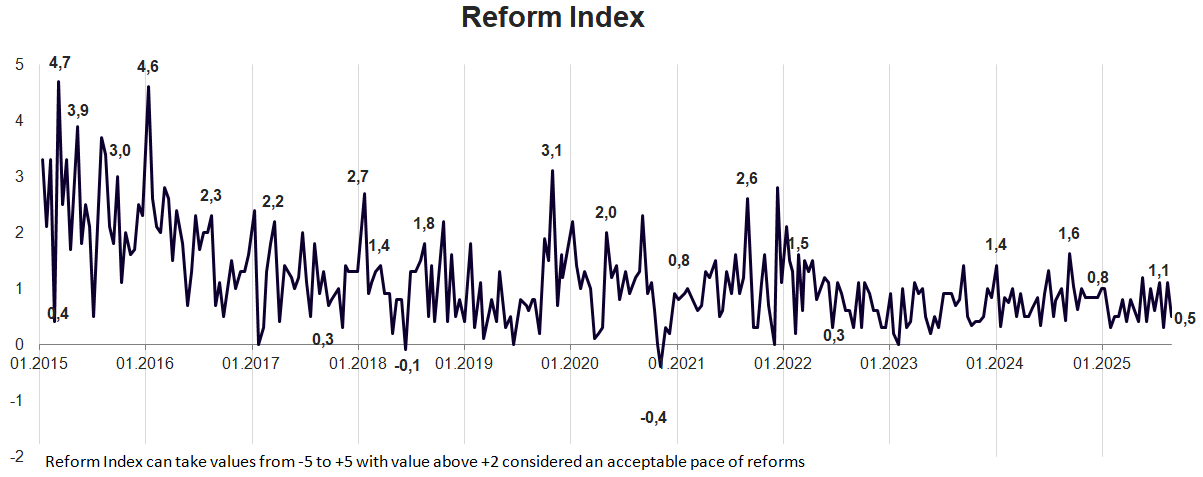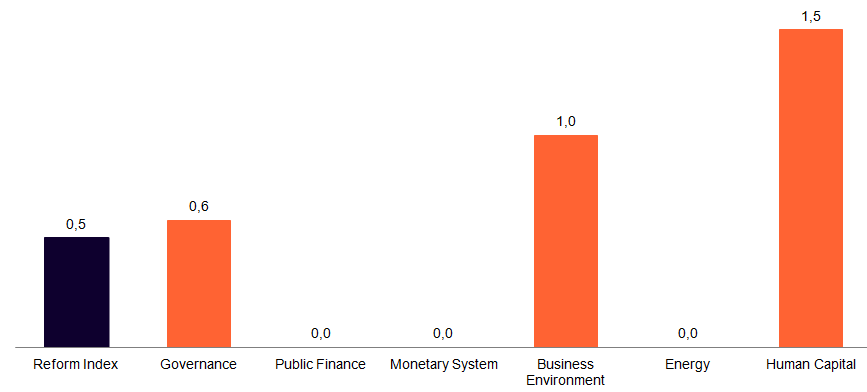Between August 11 and 24, Reform Index experts recorded seven reform-oriented regulations, six of which were resolutions adopted by the Cabinet of Ministers.
The experts, in particular, gave a positive assessment (+1 point on a -5 to +5 scale) to the government resolution that regulates the procedure for creating barrier-free routes in cities and communities. It establishes rules for developing convenient and safe pathways for people with limited mobility — including persons with disabilities, parents with strollers, and older adults. The Index value in Issue 271 stands at 0.5 points, down from 1.1 points in the previous issue.
Graph 1. Dynamics of the Reform Index

Graph 2. Values of the Reform Index and its Components in the Current Assessment Round

Barrier-free routes in settlements, +1 point
The Cabinet of Ministers approved the Procedure for Creating Barrier-Free Routes in Cities and Communities. The purpose of establishing such routes is to ensure comfortable and safe movement for people with limited mobility. The document defines a “barrier-free route” as a transport and pedestrian path in which at least 75% of facilities must be adapted to the needs of users who experience difficulties with independent movement, communication, or access to services. The concept covers not only roads and sidewalks but also government buildings, educational and medical institutions, public transport stops, public amenities, and commercial premises — with the owners’ consent.
Persons with limited mobility are those who experience difficulties moving independently, navigating their surroundings, or obtaining services and necessary information. This group may include people with permanent or temporary functional impairments (of vision, hearing, or the musculoskeletal system); individuals with temporary injuries or illnesses; persons with disabilities; children under seven and adults accompanying them; pregnant women; older adults; people with nonstandard body sizes; and those using strollers, suitcases, or bicycles, among others.
If full adaptation is not possible, facilities must include elements of “reasonable accommodation” — that is, temporary or alternative solutions such as portable or mobile ramps, call buttons for staff, and similar measures.
Local administrations and councils are responsible for planning and implementing the routes. They analyze community needs, develop route projects, and approve the exact locations of these routes. Owners and managers of facilities included in the routes are responsible for ensuring compliance with accessibility requirements (however, adaptation of privately owned facilities is carried out only with the owners’ consent). Civil society organizations may also participate in the process. Funding for the development of the routes may come from state and local budgets, as well as from international technical assistance.
Information about available barrier-free routes will be published monthly on the official website of the Ministry for Communities, Territories, and Infrastructure Development of Ukraine, on the Movement Without Barriers page.
Information about the Reforms Index project, the list of Index experts and the database of the regulations assessed are available here.
Expert commentary
Daria Kukurika, executive director of the NGO League of the Strong
“The resolution proposes a more systemic approach to accessibility: instead of isolated efforts by individual institutions or businesses, it focuses on the continuity of the environment.
At present, accessible ‘points’ often exist in isolation: even if a pharmacy has a ramp, a threshold-free entrance, or navigation aids for people with visual impairments, a high curb on the sidewalk or the absence of an audible traffic light negates that accessibility. The new procedure aims to connect such elements into continuous routes — from pedestrian infrastructure to the facilities along the way.
At the same time, a fully inclusive environment means that a person can choose not just one ‘canonical’ route but find a way to access any space they need. Therefore, it is essential that the route-based approach be integrated into a broader goal — to gradually ensure accessibility across the entire country, not just within selected ‘corridors.’
Success will depend on the capacity of local communities to conduct quality inventories, prioritize bottlenecks, and coordinate with property owners and managers. It should also be noted that, unfortunately, communities have very limited resources for this, so effective implementation will require additional support.
It is also important to monitor how these standards are implemented. If routes are selected, they must be truly accessible along their entire length, covering all facilities on them, not only those traditionally considered necessary for people with disabilities, such as hospitals and pharmacies, but also theaters, cafés, supermarkets, and so on. At the same time, the issue of accessible housing and the ability to leave one’s own apartment remains unresolved.
Overall, this marks a shift from a ‘point-based’ to a route-based approach — one that could significantly accelerate practical accessibility, provided it becomes part of a broader national accessibility policy and is accompanied by proactive financial and expert support for both communities and the private sector.”
Reform Index from VoxUkraine aims to provide a comprehensive assessment of reform efforts by Ukraine’s authorities. The Index is based on expert assessments of changes in the regulatory environment in six areas: Governance, Public Finance, Monetary system, Business Environment, Energy, Human Capital. Information about the Reforms Index project, the list of Index experts and the database of the regulations assessed are available here.
Attention
The author doesn`t work for, consult to, own shares in or receive funding from any company or organization that would benefit from this article, and have no relevant affiliations



